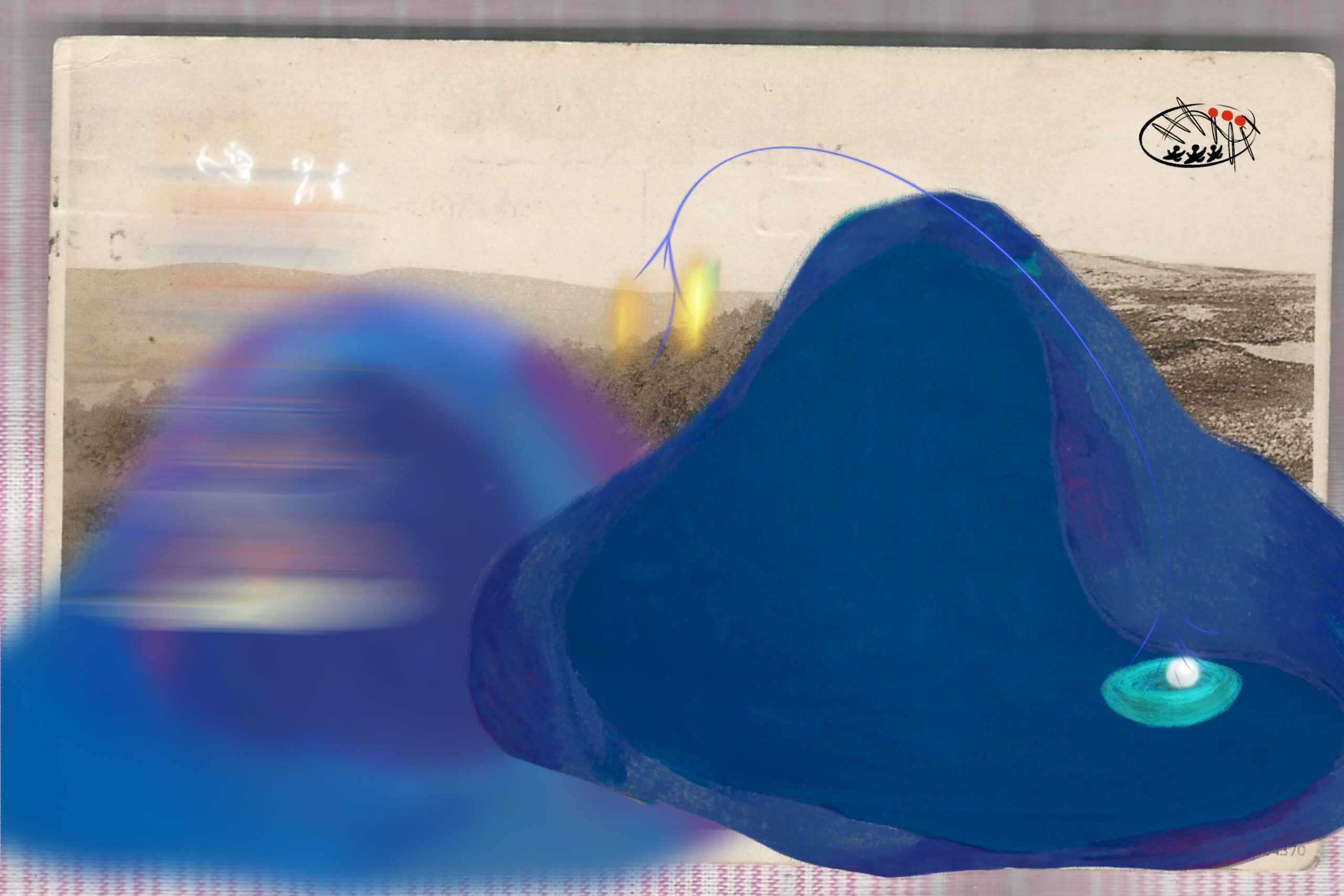MOVING UP
| 2013年05月10日 | 发表于 LEAP 19
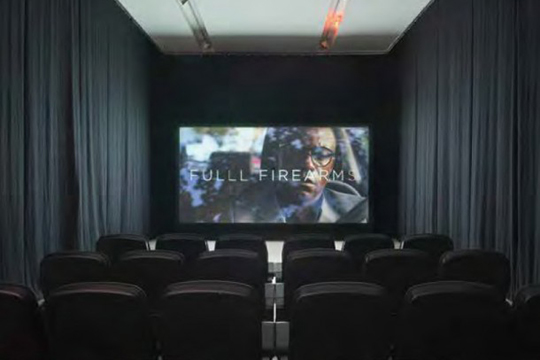
2012, installation view, FRAC Champagne-Ardenne, Reims
Courtesy of the artist and Altman Siegel, San Francisco, CA; Standard, Oslo; and Jonathan Viner, London
- EMILY WARDILL
British artist Emily Wardill revives the genre of the melodrama in her feature-length video works. In Fulll Firearms, 2011, Wardill introduces us to the life of Imelda, a protagonist convinced that the ghosts of people killed by guns produced by her father’s arms manufacturing company will haunt her for life. Inspired by the legend of Sarah Winchester, Fulll Firearms shows the possessed Imelda building a house specifically designed to appease these ghosts, which Imelda later confuses for transients that take advantage of her hospitality. The video’s narrative, while obvious in content, is increasingly structurally disrupted by sonorous and ontological effects. Similarly, Wardill’s video Sick Serena and Dregs and Wreck and Wreck, 2007, speaks to the iconography of morality by threading together footage of medieval English stained glass church windows, which originally acted as textless pedagogical devices teaching proper behavior to the illiterate masses, and contemporary approximations of the narratives proposed by these windows. Featured in the Arsenale of the 54th Venice Biennale, Sick Serena and Dregs and Wreck and Wreck borrows its cadence from the Ian Dury and the Blockheads song “Sex & Drugs & Rock & Roll,” an over-traveled twentieth-century aphorism celebrating freedom from social conventions surrounding sexuality and morality. Wardill lives in London and is represented by Jonathan Viner, London and Altman Siegel, San Francisco. Her films have been screened at Witte de With, Rotterdam; Whitechapel Gallery and Tate Britain, London. She has mounted solo shows at the Serpentine Gallery, London; Badischer Kunstverein, Karlsruhe; De Appel, Amsterdam; MCA, St. Louis; List Visual Art Center, MIT, Cambridge; Standard, Oslo; Jonathan Viner, London; and the Institute of Contemporary Arts, London.
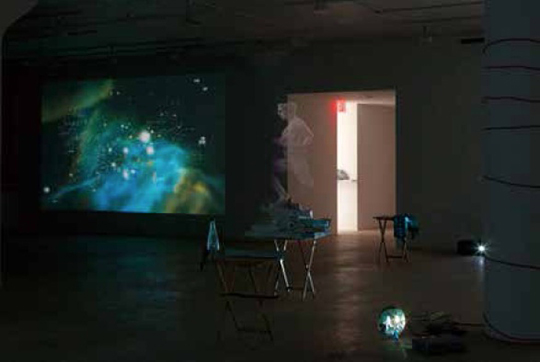
TRISHA BAGA
Trisha Baga may be New York’s new best asset, the American artist participating in two exhibitions at well-respected New York institutions in 2012. “New Pictures of Common Objects,” a group show at MoMA PS1, and “Plymouth Rock 2,” a solo exhibition at the Whitney Museum of American Art, showcase Baga’s unconventional approach to video installation, the artist strewing about sculptures, found objects, paintings, and other dressed up detritus into her video projections. Her solo gallery exhibition, concurrently on view at New York’s Greene Naftali, appears as if an Ikea showroom and a few buckets of pastel paint exploded in the gallery. Titled “The Biggest Circle,” the exhibition provides the most expansive look at her practice to date by way of three video installations, two of which are shot in 3D. Although each video ascribes loosely to a narrative structure, Baga’s work tends to reflect a splintered consciousness often (correctly or incorrectly) associated with the Internet age. A graduate of New York’s Cooper Union and Bard College, Baga has had solo exhibitions at Vilma Gold Gallery in London and Kunstverein Munich and has exhibited at EAI, Johann Koenig Gallery, Performa09, The Housatonic Museum, LAXART, and El Centro Cultural Montehermoso. A 2012 Louis Comfort Tiffany Foundation grantee, Baga lives and works in New York and is represented by Greene Naftali.

OSCAR MURILLO
When both the über-chic fashion label Comme des Garçons and the Serpentine Gallery asked Oscar Murillo to work on projects with them, the Colombian-born, London-based artist combined efforts and threw a party for his family in the Serpentine’s outdoor pavilion and had it hosted by Comme de Garçons. Murillo titled the festivity “The Cleaners’ Late Summer Party with Comme des Garçons” as he and his entire immediate Colombian family have worked as house cleaners at some point in their lives. The obvious class-divide between the normal patrons of luxury trades such as fine art or high fashion and those house cleaners provided a cultural car crash effect, to the elation of the artist. For his exhibition at the Rubell Collection in Miami during the 2012 round of Art Basel Miami Beach, Murillo presented five of his signature large canvases painted with oil sticks. These paintings, often left on the floor to collect dirt and other studio detritus, feature words or word fragments such as “mango,” “chorizo,” or “yoga,” all terms with major cultural connotations. His work could be said to channel the scribbles of Cy Twombly or the bleed-through effects of Joe Bradley, another young market darling. Born in 1986, Murillo lives and works in London and is represented there by Stuart Shave/Modern Art and Carlos/Ishikawa. He is a 2012 graduate of the Royal College of Art in London, and also studied at the University of Westminster, London. He will launch a solo project at Stuart Shave/Modern Art in 2013, and has recently presented solo exhibitions at Hotel, Cole Contemporary, and Carlos/Ishikawa, all in London. He has been included in group shows at Nicole Klagsbrun, New York; Brand New Gallery, Milan, Italy; Mihai Nicodim Gallery, Los Angeles; and the Amphitheatre, in Arles, France.
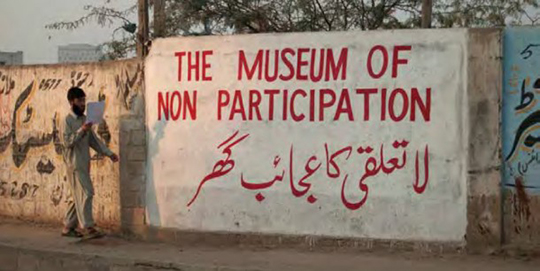
KAREN MIRZA/BRAD BUTLER
Karen Mirza and Brad Butler redefine what it means to have a studio-based practice— rather than exclusively create art objects, the London-based duo concentrate their efforts on ephemeral social-based projects, to include curating, filmmaking, installation, performance, and publishing. “The Museum of Non-Participation” (a flummoxing title, to be sure) took place at both a Pakistani barber shop in London’s Bethnal Green and outdoors in Karachi, Pakistan. The fruit of an Artangel commission, “The Museum of Non-Participation” instituted Urdu classes in the back of Bethnal Green’s Pakistani barbershop while the Karachi version featured a “museum” of sorts, or a site of social activities, with no walls. Events were documented as photographs of sites in Karachi with geometric lines traced directly onto the city’s surfaces. Mirza and Butler met in the late 1990s while students at the Royal College of Art in London and have worked collaboratively ever since. In addition to their artistic practice, Mirza and Butler initiated no.w.here, a non-profit organization supporting film production and curatorial projects, in 1999. They have recently been featured in group exhibitions at Witte de With, Rotterdam; Kunstverein Medienturn, Graz; Manifesta 9, Genk; Serpentine Gallery, London; Heidelberger Kunstverein, Heidelberg; and Whitechapel Gallery, London, among others. In April 2013, they will present “The Museum of Non-Participation: The New Deal,” at Walker Art Center in Minneapolis. They are represented by Waterside Contemporary, London and Galeri NON, Istanbul, and were shortlisted for the Jarman Award in 2012.
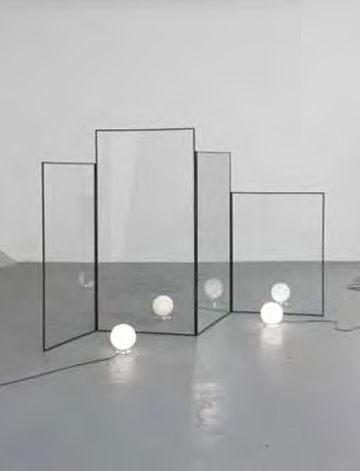
2012, steel frame, crystal glass, sandstone, two Art-Deco lamps, cable, light bulb Dimensions variable
ALICJA KWADE
Alicja Kwade approaches sculpture with the wit of a conceptualist, the dreamlike quality of cinema, and the fervency of youth. “The Heavy Weight of Light,” her recent exhibition at Harris Lieberman and her first in New York, features a bevy of naturally hard materials slumped against the wall in a Hannah Hoch-esque limp. Mirror, strips of hard wood, and pipes sit against the wall in an L-shape while an installation of pocket watches tick feverishly in a back room. The main gallery space features an installation of orb lights, mirrors, and panes of glass that activate as the viewer walks around it, obscuring the crystal-ball lights with panes of opaque mirror. An earlier work from 2009, Nissan [Parallel World 1+2], is similarly uncanny and phantasmagorical in effect, taking her lover’s left-hand-drive Nissan Micra and identically replicating it with another, right-hand-drive model down to its rusted bumper dent and the rubbish in its backseat. Born in Katowice, Poland, Alicja Kwade lives and works in Berl in, Germany. She has recently presented projects at Harris Lieberman, New York; Grieder Contemporary, Zurich, Switzerland; and Mother’s Tankstation, Dublin, Ireland. Kwade recently participated in “Made in Germany Zwei,” at three institutions in Hanover, Germany as well as group exhibitions at KW, Berlin; K21, Düsseldorf; CCA Wattis, San Francisco; Kunsthalle Nürnberg, and Kwadrat, Berlin. She is represented by Galerie Christina Wilson in Copenhagen, Denmark, and Johann König, Berlin, and will present a solo exhibition at Kunstmusen Krefeld in 2013.
